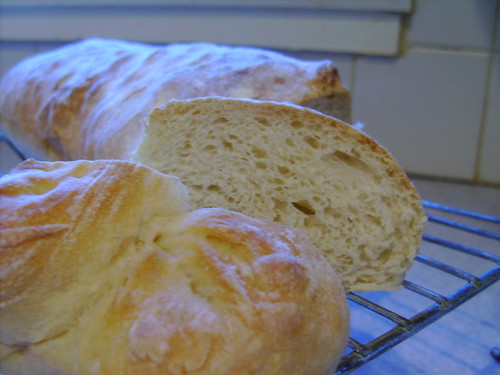Yesterday I decided to attempt the poolish Ciabatta from the Breadbaker's Apprentice. Well, I thought I did everything good, it looked like it was going to be great, but when I cut into it, the crumb wasn't very big at all. I'm wondering what I did wrong.
Did I not give it enough kneading? I didn't flip it upside down before baking, it didn't say to, should I have? I was bit frustrated. It still tasted good, but it wasn't what I was hoping for. I did my best not to degass it. It was more like French bread then ciabatta... I still don't know very much about
bread so I was hoping someone could help out!


Thanks! =3
When I make my Ciabatta, that yields 2 loaves, I gently divide my dough in half and place it in 2 different bowls, for the last rise before shaping. That way I don't have to worry about degassing it when I go to put it on the pan for the final rise. I just kind of pour it out, in an elongated fashion, onto the baking pan, give it a little tug and push to shape and let it do its thing.
I get my nicest crust when I bake it on a Silpat at 425 using the water in the pan method and a spritz to the sides of the oven every 2 minutes for the first 6 minutes. I remove the pan of water at 10 minutes.
A great recipe to learn Ciabatta is the one that was on here, the Almost 95% Hydration Ciabatta. The instructions are very detailed, if you follow them you will have holey ciabatta success I predict. I've been asked about ciabatta by a few people, I always send them to that recipe first, to perfect the texture, holes, very wet dough, etc., then tell them to go from there to one with sourdough or poolish for more depth of taste.
By your crumb, I would say that that dough is also seriously under-hydrated for a ciabatta. What % hydration is that recipe, and did you add flour when kneading? While I am a firm believer in "the flip", with a dough as non-ciabatta-like as that, it wouldn't have made a difference. The flip is more necessary IMO with a great ciabatta with a very wet dough and big holes, it helps make sure you don't just get all big holes at the top, in addition to making for a very nice appearance in the flour patterns on the top.
Yours looks beautiful by the way, that is a beautiful, beautiful bread by any other name!!
Maybe if someone has a link for the recipe I'm talking about they could post it -- I really think you will learn from it and have holey ciabatta success.
At a glance it looks like you're overworking or overhandling your dough. Ciabatta dough needs to handled with extreme gentleness. Look at Rose Levy Beranbaum's recipe for ciabatta in her: BREAD BIBLE. It's high hydration dough with lots of flour on the work surface during the final dividing and shaping and very little handling. You should be seeing a few large blisters the size of a quarter on the top of the dough when it's at its peak, indicating it's ready to go into the oven. If you're opening and closing your oven door to spritz, then that could also be a problem. You need contant heat during the first 8-10 minutes of baking to get good oven spring. Try using a preheated pan or skillet (directly under the oven rack holding the ciabatta) and adding 1/3 cup of water immediately after you put your bread into the oven, at the onset of the baking cycle, to creat the steam rush you need. Close the oven door and keep it closed for at least the first 10 minutes of the bake cycle. Then you can turn your pans around at mid point. I use Rose Levy's recipe frequently and have never had a problem getting large holes. In fact, I get seriously large holes each time I make ciabatta from her recipe.
Good luck
HO
Brigid,
"Hydration"
Check out this link :)
http://www.pizzamaking.com/forum/index.php/topic,5029.0.html
Jerry
I've been playing around with hydration since my BBA poolish ciabatta turned out like Jolly Green Giant slippers. Good taste, just poofy and not the crumb I expected.
I increased the hydration when mixing up Leader's baguette l'ancienne, essentially because I heat with wood and the air is very, very dry in my home. I overdid it a bit because the result was a nice ciabatta with a delightful crumb.
Edible learning experiences. Now, if only I could figure out a way to bake bread inside my woodstove...
Thanks everyone for the reply! (sorry it took so long to get back!)
I'm not sure what percentage the hydration is of the recipe, I don't have the book with me at the moment. Next time I'm definitely going to try more water. My dough rose so nicely, and it had lots of air bubbles before I put it in the oven. My yeast is definitely active...I think it must be not enough water and over handling. I'll definitely try this again so I can get it right!
- http://colettesbakery.blogspot.com/